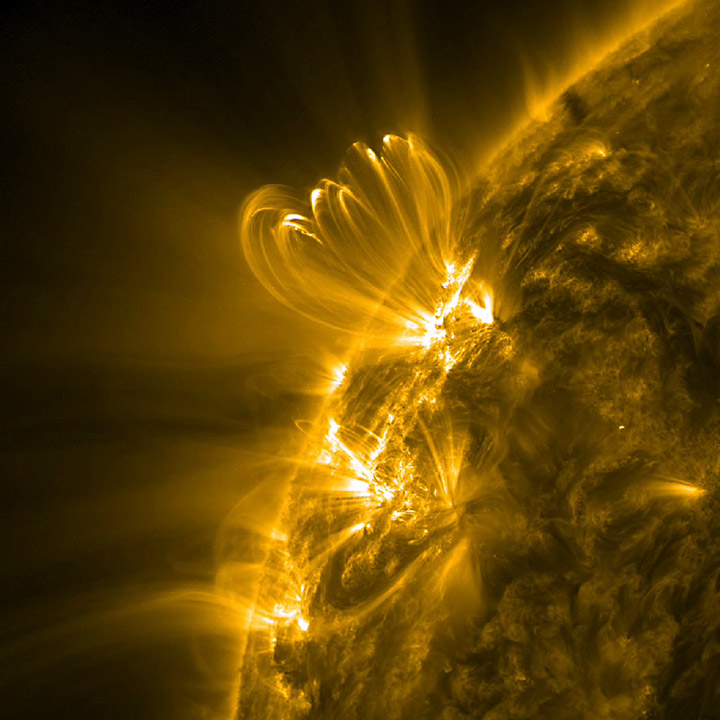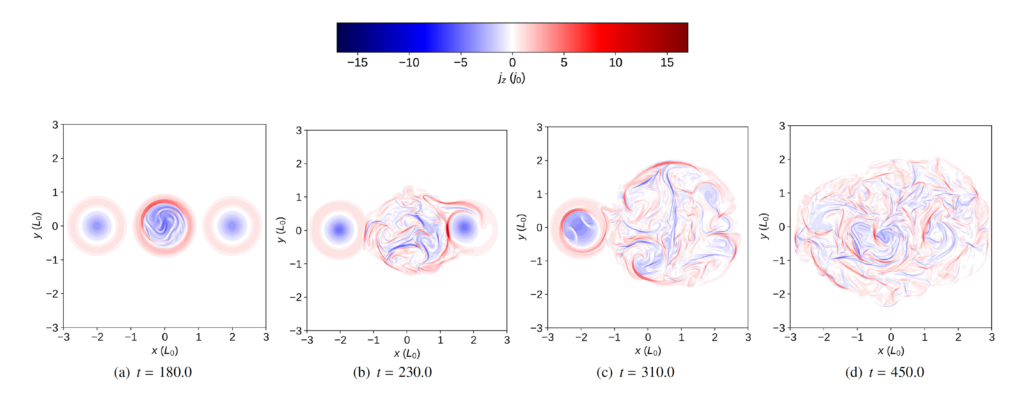This guest post was written by Cosima Breu. Cosima is a second year PhD student at the Max Planck Institute for Solar System Research in Göttingen. Her research focuses on the coronal heating problem. She uses magnetohydrodynamics simulations to study the interaction of the magnetic field and the plasma in the solar atmosphere. When she is not currently plotting or debugging anything, she enjoys reading Sci-Fi books, photography and rock climbing.
Title: Coronal energy release by MHD avalanches: continuous driving
Authors: J. Reid, A.W. Hood, C.E. Parnell, P.K. Browning, P.J. Cargill
First Author’s Institution: School of Mathematics and Statistics, University of St Andrews (St Andrews, UK)
Status: Published in Astronomy and Astrophysics, open access
Visible only as a halo around the Sun when the light from the solar disk is blotted out, for instance during a solar eclipse (Figure 1), the outer solar atmosphere (the corona) has been posing riddles to astronomers since the first eclipse observations thousands of years ago. The corona consists of hot and thin plasma. The identification of emission lines of highly ionized atoms in the coronal spectrum lead to the discovery that the temperature of the corona is over a million Kelvin while the photosphere, the visible surface of the Sun, is much cooler, with a temperature of just a few thousand Kelvin.

Why is the solar atmosphere much hotter than the surface?
The dynamics of the corona is dominated by the magnetic field. Loops of magnetic field lines connect regions with opposite magnetic polarity, forming an arc of hot and dense plasma (Figure 2). The energy necessary to heat the corona is thought to be either transported upwards by waves or originate from slow motions of the photosphere which shuffle around the magnetic field leading to braiding of the field lines. Similar to winding up a spring, this process stores energy in the magnetic field which becomes increasingly complicated as it gets tangled. The magnetic field can store only a finite amount of energy. If a spring is wound up too tight, it is eventually going to snap. Equivalently, the magnetic field lines can reconnect, they break and become rearranged in a less twisted state. This makes it possible to tap into the stored magnetic energy. In a similar manner to a filament in a light bulb being heated up by the current passing through it, currents that form when the magnetic field is entangled are dissipated due to Ohmic resistivity in the corona and heat up the plasma. In the field line braiding picture, the reconnection events lead to a multitude of small bursts of heating, the so-called nanoflares.

Magnetohydrodynamic instabilities
One of the mechanisms that allow access to the stored energy resources is the kink instability which can develop when the twist of a bundle of magnetic field lines, a magnetic flux tube, exceeds a critical value, like a rubber band which is twisted until a kink forms in the band. When an initially straight flux tube is deformed so that it becomes partially curved, the field lines are compressed at the inside of the bump. The magnetic pressure at this side increases which leads to a force in the same direction as the the original displacement, making the bump grow even further.
Previous studies have shown that an instability in one loop can destabilize a neighbouring one and lead to energy release also in this second loop. Numerical experiments have been performed involving a box filled with a large number of bundles of magnetic field lines in which one initially unstable loop starting a chain reaction managed to destabilize and engulf most of the remaining loops. These previous works, however, assumed that the magnetic field is in equilibrium before becoming unstable. On the surface of the Sun, a coronal loop is never left alone – its evolution is constantly being driven by the convective motions at the footpoints where it is anchored in the photosphere. The authors focus on the more realistic scenario when the magnetic field is still continuously moved around during the onset of the kink instability.
A coronal loop in a box

The authors perform a series of three-dimensional magnetohydrodynamics simulations accounting for conservation of mass, momentum and energy. The coronal loop system is modelled as three twisted cylinders of magnetic field lines. The footpoints of these threads are rotated in opposite directions at the top and bottom of the simulation box to tangle the magnetic field lines. The central thread is twisted faster than the other two and thus is the first to come undone. The magnetic energy in the twisted thread increases while the field lines become more and more intertwined until the the kink instability kicks in and the flux tube is eventually disrupted. The first sign that a thread is about to be torn apart is the plunging of the magnetic energy after which the kinetic energy starts to grow exponentially. When the instability develops, crescent-shaped currents start to form in the loop due to the shearing of the magnetic field, eventually fragmenting into many small current sheets where field lines can reconnect and the corona is heated. The development of the current sheets and the disruption of the threads is shown in figure 3. The magnetic field of the first unstable thread starts to interact with the other threads and their field lines become connected. One after the other, the threads unravel, leading to a state without discernible order. The continuous driving leads to complex braiding and the spontaneous generation of currents.
Heating by MHD avalanches
Although it is known that the magnetic field of the Sun plays an important role for the transport of energy from the solar surface into the atmosphere, it is still an unsolved problem how exactly the energy is carried upward into the corona and how it is eventually released. The authors show for the first time that a single loop which becomes unstable due to plasma motions at the solar surface can trigger a chain reaction and turn a well-ordered large scale magnetic field into a much more complex configuration. An instability in one of the threads leads to energy release also in the other two. This process results in a continuous background heating with small bursty energy release events on top as the motions at the photosphere continue to braid the field lines. These avalanches show similar characteristics to a system which exhibits self-organized criticality (SOC), where a disruption spreads after a parameter has reached a certain critical threshold, with the difference that no steady state is reached in the numerical experiments conducted in this study. Longer simulation runs will be needed to determine whether the system eventually reaches a steady state.
In future research, the authors plan to address the question whether these bursty heating events are related to the proposed nanoflares. Another open question is the location of the heating events. The heating could be spread throughout the atmosphere or concentrated where the coronal loops are rooted in the photosphere. While there is still work to be done and more computational power needed to answer these questions, this study demonstrates that MHD avalanches do provide a possible mechanism to set free magnetic energy in the solar corona and maintain the high temperature of the solar atmosphere.




